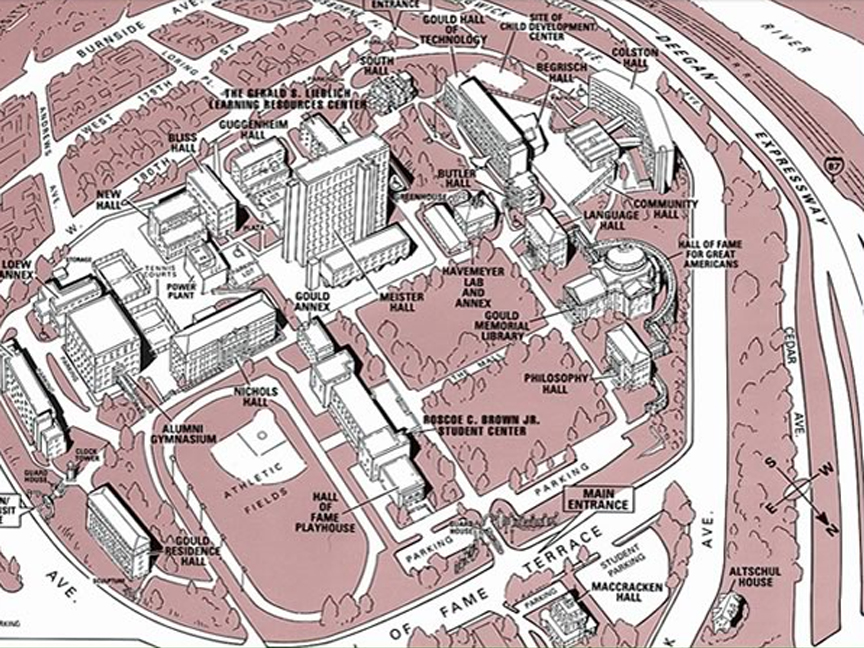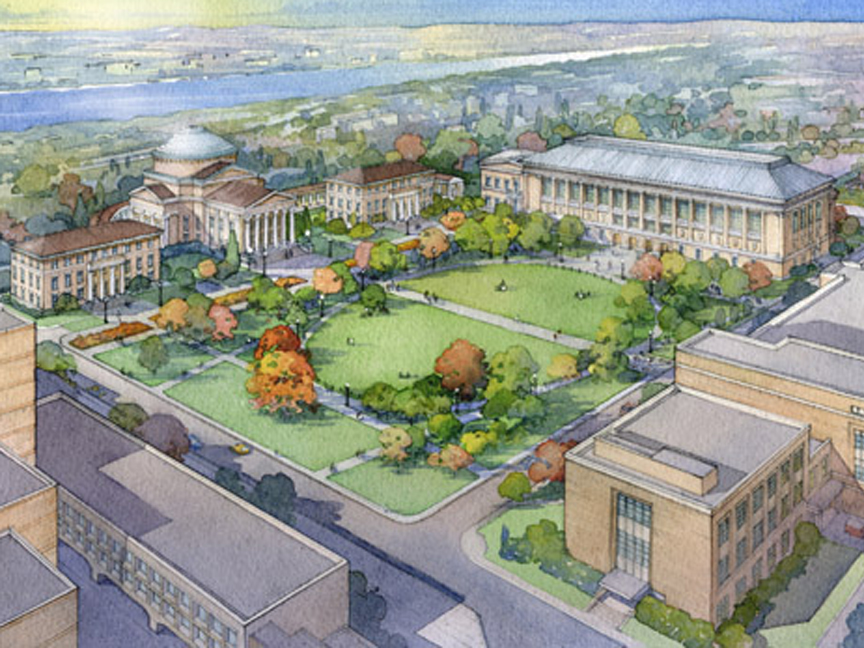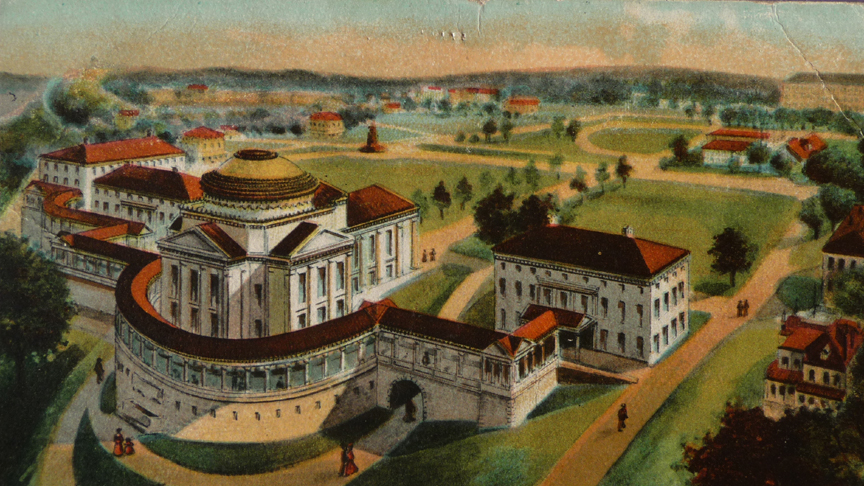
- Gould Memorial Library, 1894-99, is called “one of Stanford White’s most important achievements” by his biographer, Paul R. Baker.
Ground has been broken on a new Bronx Community College building by Robert A.M. Stern that will leave Stanford White’s Gould Memorial Library off-center on its historic quadrangle.
Part of the City University of New York, the college occupies what was originally the north campus of New York University. Stanford White designed a campus master plan for NYU in the 1890’s, and four structures designed by him were built according to it. They formed the head of a proposed quadrangle inspired by Thomas Jefferson’s design for the University of Virginia. The structures built to White’s design are Gould Memorial Library, two flanking academic halls and the crescent-shaped Hall of Fame colonnade centered behind them. The library is modeled on the Pantheon in Rome, and faces a central Great Lawn as conceived in White’s master plan. The Guide to New York City Landmarks describes the library as “one of White’s greatest buildings” – an almost universal appraisal – and notes that “the importance of this design in White’s work was recognized in 1919 when his peers chose to create a pair of bronze doors for the library as a White memorial”. Buildings introduced since White’s time have roughly followed his master plan on the south and east sides of the quadrangle, producing the Great Lawn he planned. The north side of the Lawn has remained vacant, used as a parking lot, until now. About to rise on this site is the new North Instructional Building and Library, designed by Robert A.M. Stern Architects. Stern’s design will cover not just the area allocated for buildings in White’s master plan, but much of the Great Lawn as well. Encroached upon by the new building, what is left of the Lawn will be off-center with the library, destroying the fundamental premise of White’s master plan and devaluing one of the nation’s most architecturally significant campus cores.
Unlike White’s structures, the Great Lawn is not protected by landmark designation, a particularly regrettable oversight on the part of the Landmarks Preservation Commission. The Lawn and the structures were conceived as a piece, open space and buildings reinforcing each other’s importance. As the exterior focus of the campus, the Great Lawn is intentionally aligned with its interior focus, the library’s great rotunda, their classically symmetrical spaces linked and sequentially experienced by way of a processional path centered on Lawn and buildings. A patently organic part of the total design, the Lawn is certainly as worthy of designation as the buildings whose quality it enhances. Had it been designated, construction on the Great Lawn would certainly never have been allowed by the Landmarks Commission. Lacking designation, the Lawn depended on CUNY’s responsible stewardship and its hired architects’ accountability for preservation.

A campus map with Stanford White's structures and Great Lawn at center-right. The new North Instructional Building and Library will rise on the parking strip at lower right of the Lawn and on the lawn above it.
The siting of the new building contradicts recommendations of a 2005 Conservation Master Plan prepared by the firm Heritage Landscapes under a $228,000 grant from the Getty Trust. This document, on view at the Getty Center, states that its “high priority . . . is to highlight possible locations of future buildings with respect to historic configurations and character-defining features”. It says of one proposed building, which would eventually be Stern’s, in particular:
“Some discussion about siting the building on the current north parking lot has also ensued. The preservation conservation team recommends the proposed building be constructed on the site to the north across the Hall of Fame Terrace, not on the site of the north parking lot [which] provides insufficient space for a new building of the size being considered, some 90,000 square feet. If such a large building were to be located on the parking lot site, it would likely involve shifting the northern section of the Great Lawn drive and narrowing the north panel of the Great Lawn, thus altering the historic configuration of this space. Construction of this size building raises concerns about impacts on the Historic Campus Core, which are not in agreement with the landscape preservation treatment objectives previously outlined. From a preservation perspective, Heritage Landscapes recommends retaining the current drive alignment and Great Lawn configuration and recommends that alternate building sites be considered.”
Heritage Landscape’s conservation plan also documents all of the campus’s master plans, including some from 1912 and later by Frederick Law Olmsted Jr. These plans were conceived after White’s ensemble was built but before construction of any major buildings defining the sides and foot of the lawn. They show side buildings located closer to the center of the lawn, forming a narrower quadrangle. Although these plans were made irrelevant when new buildings were later constructed according to White’s original plan, Stern self-servingly uses them to sanction the bizarre unilateral forward placement of his 100,000 square foot building. In written and verbal presentations of the project, Stern’s office has asserted that his building’s placement will result in “a quadrangle similar to the original landscape design for the campus by Olmsted”. (This statement would suggest to anyone who didn’t know better that it was the designer of Central Park – and father of Olmsted Jr – who had created the original campus plan and that Stern is acting on no less divine an authority, a breathtakingly sleazy ploy even for someone of Stern’s facile means.) At least Olmsted Jr’s plans maintained the symmetry at the heart of White’s master plan, even as they abandoned precisely what distinguished it from Jefferson’s and made it White’s own, the embracing impulse that placed the library over the lawn’s center, rather than at its end.
A similarly deceptive strategy is followed on the website of Heritage Landscapes, the firm whose recommendations Stern disregarded in the placement of his building. Having now drunk the Kool-Aid, Heritage ransacks it research for names with which to muddy the waters and even follows Stern’s ridiculous invocation of Central Park, this time by way of Olmsted’s partner Calvert Vaux:
“In researching the campus landscape history, Heritage Landscapes located an 1894 design plan by Calvert Vaux and discovered an Olmsted connection. While the Vaux plan was preliminary and not implemented, from 1912 to the 1920s a series of proposals, plans and correspondence by Frederick Law Olmsted Jr, Olmsted Brothers Landscape Architects, and Frank Miles Day, Day and Klauder Architects, influenced the core campus evolution.”
Just how they influenced it isn’t stated. Maybe the kind folks at Getty should get their money back.

- Stanford White’s 1892 master plan shows a wide Great Lawn centered on Gould Memorial Library and the Hall of Fame Terrace at top. The structures across the top of the Lawn were built to White’s design. Buildings shown at the sides and bottom of the Lawn show White’s proposed locations for future buildings.

- Frederick Law Olmsted Jr’s 1912 master plan moves proposed side buildings closer to the center of the Great Lawn, substantially narrowing it. This plan was never implemented, and later buildings were located in line with White’s original master plan on the left side and bottom of the Lawn, while the right side remained vacant.

- Robert A.M. Stern’s 2006 master plan shows existing buildings at top, left and bottom and his new building at right. The left side of the Lawn corresponds to White’s planned boundaries for it, the right side to Olmsted Jr’s.
This double-talk can’t hide what’s plain as day on any drawing of the new campus plan, the negation of White’s larger concept and the diminishment of his library’s primacy. The new building isn’t just in the wrong place; its scale is far greater than what White had envisioned and suggested by way of the academic halls he designed on either side of Gould Memorial Library. (Had CUNY only heard of Stern’s academic credentials and not his ego?)

Robert A.M. Stern Architects' rendering showing the new North Instructional Building and Library at right. Foreground rooftops skillfully crop the quad into a semblance of symmetry, but the dominating scale of the new building has nowhere to hide.
What kind of building does the College get for $56 million and an imponderable loss of cultural heritage? A giant knockoff of Henri Labrouste’s Bibliotheque Ste. Genevieve, phoned in with minimal adjustment to program and site. The first floor contains giant classrooms that speak of unconscionable teacher-student ratios, with tiny windows so they can stand in for Labrouste’s first floor stacks and offices. This masquerade takes priority over green architecture considerations like the proven benefit of natural light to classroom learning. (Stern’s website touts the building’s LEED Silver status as if it weren’t the minimum level required by New York City law.) Upstairs, the new library has 45 foot ceilings, producing a huge volume of unused space that contributes greatly to the building’s overreaching bulk. CUNY would certainly have better spent the public’s money finding a way to put Gould’s spectacular interior to more vital use. The rationale for Labrouste’s Bibliotheque as Stern’s model? It inspired Charles McKim in his design of the Boston Public Library, and McKim was Stanford White’s partner in the firm of McKim, Mead & White. As with the “Olmsted connection”, associations make it right.
Here’s an association that CUNY Chancellor Matthew Goldstein might contemplate as he hands White’s campus over to Stern; in 1981 the great architecture critic and historian Reyner Banham published a dual book review (“The Ism Count” in New Society) of the Academy Editions monograph, Robert Stern, and Whiffen and Koeper’s survey, American Architecture 1607-1976. After noting Stern’s “complete lack of aesthetic scruple” and “an almost complete lack of congruence between his facades and his plans”, Banham asks, “what’s it all got to do with ‘real architecture’?” He notes that Stern doesn’t rate a mention in American Architecture, which he proceeds to test for trendiness by checking the percentage of its pages dedicated to McKim, Mead & White, then riding a wave of resurgent interest. Banham finds that the book allots Stanford White’s firm two percent of its page count, “perhaps even over-compensating for current fads in historiography, though the text is full of appreciation of the real virtues and qualities of their best works”. Banham ends by wondering whether American Architecture “may go through enough editions over the years to find a place for Bob Stern and Post-Modernism” and concludes, “I wouldn’t like to bet what percentage of the page count they will get”.
Banham was right that Stern would never be recognized for “real architecture”, but could hardly have imagined what a reputation he’d build on make-believe. It‘s New York’s loss that CUNY can’t tell the difference.

An early view of the campus shows the lawn as laid out by Stanford White, encircled by drives and awaiting its perimeter of buildings.
I appreciate your concern in trying to preserve something beautiful, but the article seems a little myopic. The White buildings are jewels, as is his conception, but the campus as a whole is an appalling garbage can of architectural fads long past their freshness dates. If one could somehow block out everything except the great lawn and White’s buildings from view, as your illustrations do, things wouldn’t be so bad. But it’s not possible if you’re there in person. I suggest planting way more large-growing trees.
I don’t understand so much ranting on Stern. If anything, the kind of un-hip, un-ironic stuff he does will not have to be tolerated, or more likely, suffered by future generations. Surely there are enough haute couture tastemakers in this town to satisfy ravenous architecture groupies. Must everything submit to the fickle whims of Dame Fashion? As you say, Stern should have been more sensitive to place and space, but BCC proves they could do so very much worse than Stern, and good god they have. Repeatedly.
For example, that lulu of a newish building that overlooks Sedgewick Ave. and the Deegan surely must have been designed with a Moscow Star Trek convention in mind, sometime in 1970. I think it’s called Colston Hall on your map. The word ‘insensitive’ doesn’t begin to describe placing it next to the Hall of Fame. ‘Autistic’ may describe this ignoble atrocity better.
Tulip trees (Liriodendron tulipifera) would be a good choice because they are the largest-growing trees here on the East Coast. Thanks for the interesting blog and your thoughts. KM
Some photos of the construction underway, taken on the afternoon of 7/16/09.
http://www.flickr.com/photos/46871223@N00/sets/72157621583516124/
Our beloved Panthe-on-The-Harlem …
HCY
Chair,
Friends Of The Gould MemoriaLibrary & The Hall Of Fame For Great Americans @ BCC / CUNY
Poor Stanny…he must be rolling in his Long Island grave.
I had to drive back from Queens to New Jersey yesterday and stopped off in my old neighborhood. I visited the former NYU campus. The library is built, and boy, does it screw up a vista I’ve been familiar with since the early 1960s. It’s much too big for the site, and too close to the other buildings. The bricks and trim match the other sites, but it’s as if an obese, giant relative has come to sit not at, but on, the table. There’s a lot of open space on that campus, and some truly hideous buildings that could have come down. But the whole thing is sad. One of the dumber things NYU ever did was to sell that campus. It deprived the whole area of life. The campus is a ghost town on the weekend. And why? So NYU could focus its attention completely on the ruination of Greenwich Village.